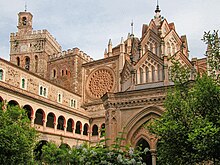Santa María de Guadalupe
 |
|||||||||||||||||||
| UNESCO World Heritage Site | |||||||||||||||||||
|---|---|---|---|---|---|---|---|---|---|---|---|---|---|---|---|---|---|---|---|
| Location |
Spain |
||||||||||||||||||
| Criteria | iv, vi | ||||||||||||||||||
| Reference | [http://whc.unesco.org/en/list/665
|
||||||||||||||||||
| Coordinates | 39°27′10″N 5°19′39″W / 39.4528°N 5.3275°W | ||||||||||||||||||
| Inscription | 1993 (17th Session) | ||||||||||||||||||
|
[]
|
|||||||||||||||||||
 |
|
| UNESCO World Heritage Site | |
|---|---|
| Location |
Spain |
| Criteria | iv, vi |
| Reference | 665 |
| Coordinates | 39°27′10″N 5°19′39″W / 39.4528°N 5.3275°W |
| Inscription | 1993 (17th Session) |
|
[]
|
|
The Royal Monastery of Santa María of Guadalupe (Spanish: Real Monasterio de Nuestra Señora de Guadalupe) is a Roman Catholic monastic establishment in Guadalupe, in Extremadura, Spain. It is located at the feet of the eastern side of the Sierra de las Villuercas and was one of the most important monasteries in the country for more than four centuries. UNESCO declared it a World Heritage Site in 1993.
The monastery had its origins in the late 13th century, when a shepherd from Cáceres, named Gil Cordero, discovered on the bank of the Guadalupe River a statue of the Blessed Virgin, which had been apparently hidden by local inhabitants from Moorish invaders in 714. On the site of his discovery a chapel was built, dedicated under the title of Our Lady of Guadalupe.
King Alfonso XI, who visited the chapel more than once, invoked Santa Maria de Guadalupe in the Battle of Rio Salado. After gaining the victory, he ascribed it to the Madonna's intercession, declared the church at Guadalupe a royal sanctuary and undertook an extensive rebuilding program.
In 1389, the Hieronymite monks took over the monastery and made it their principal house. Construction works continued under the auspices of the order's first prior, and in 1474 Henry IV of Castile was entombed in Guadalupe, next to his mother.
...
Wikipedia

